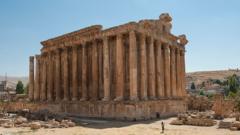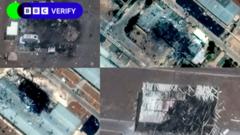The recent escalation of conflict in Lebanon has prompted archaeologists to warn that Israeli air strikes are placing ancient ruins, such as Baalbek and Tyre's Roman temples, at serious risk. While there is currently no evidence of damage, experts fear the proximity of military actions poses a threat to these UNESCO World Heritage sites, emphasizing the cultural loss such destruction would entail.
Archaeologists Sound Alarm as Israeli Strikes Threaten Cultural Heritage in Lebanon

Archaeologists Sound Alarm as Israeli Strikes Threaten Cultural Heritage in Lebanon
The ongoing conflict in Lebanon raises concerns about the preservation of ancient ruins amidst increasing Israeli air strikes targeting areas near historical sites.
The recent air strikes conducted by Israel in Lebanon have raised red flags among archaeologists who fear for the safety of significant cultural heritage sites. Among these is Baalbek, renowned for its ancient Roman temples, which have stood for over two millennia. Last Wednesday, an Israeli strike hit a car park located only meters away from this UNESCO World Heritage site, resulting in concerns for the integrity of the surrounding historical structures.
"Such an incident could lead to irreparable damage," warned Graham Philip, an archaeology professor at Durham University. "Baalbek is irreplaceable; to bomb it would be a colossal crime." The situation escalated sharply after late September when Israel intensified its military campaign against Hezbollah, launching thousands of air strikes that have now found their way closer to Lebanon's cultural landmarks in the Bekaa Valley and Tyre.
Although the Israel Defense Forces (IDF) maintain that their strikes target military installations, the close proximity to Baalbek raises alarm. Recent videos of air strikes show thick clouds of smoke rising alarmingly close to the Roman ruins. Local archaeologists, such as Joanne Farchakh Bajjaly, expressed particular concern for Baalbek: "The bombing risks areas essential to our history, including the temples. No military facilities are present there, making it hard to comprehend the ongoing strikes".
While IDF asserts it has protocols to prevent damage to sensitive sites, the reality on the ground has left civilians seeking refuge near these historical locations, believing they are safer within the walls of heritage sites. This misguided sense of protection has put lives at risk, prompting urgent warnings from local authorities against congregating in the area.
Israeli archaeologist Erez Ben-Yosef acknowledged the precarious position the ongoing war has created for the preservation of heritage sites. He emphasized, however, that efforts within the Israeli military are in place to avoid damage to these cultural treasures.
As the situation develops, experts like Graham Philip are vigilant, recalling recent conflicts where similar archaeological sites in Gaza suffered considerable destruction. A survey revealed that at least 69 cultural heritage sites in Gaza were affected by the ongoing conflict against Hamas. Philip emphasized the profound connection such structures hold for a society’s cultural identity: "Destroying these sites would be akin to decimating the soul of a community."
As the conflict continues to unfold, the future of these ancient relics hangs in the balance, serving as a poignant reminder of the cost of warfare on history and heritage.






















